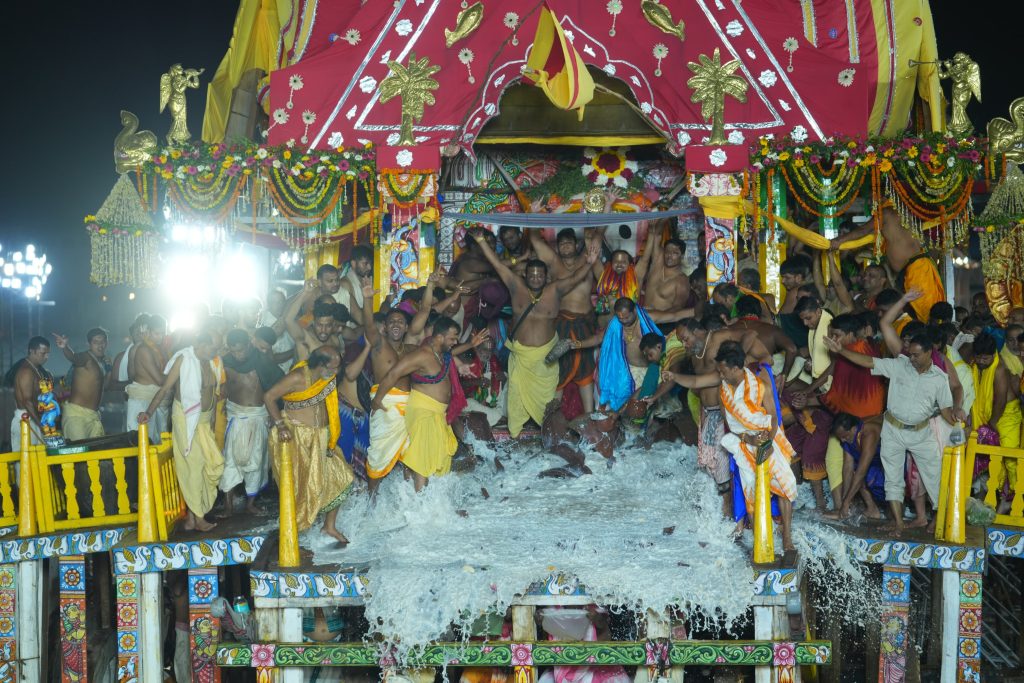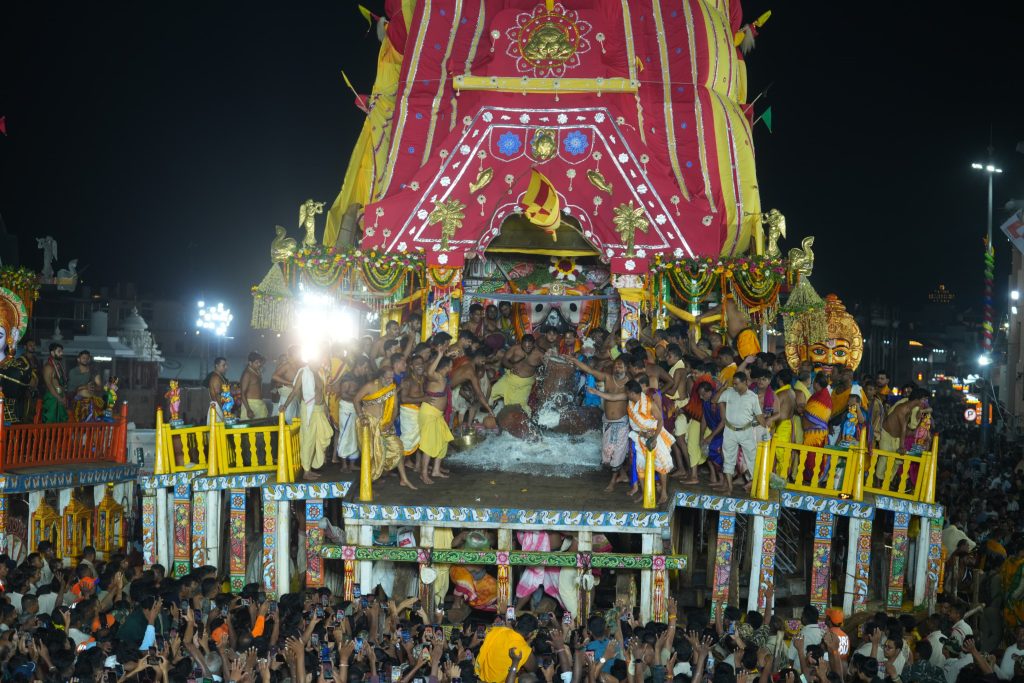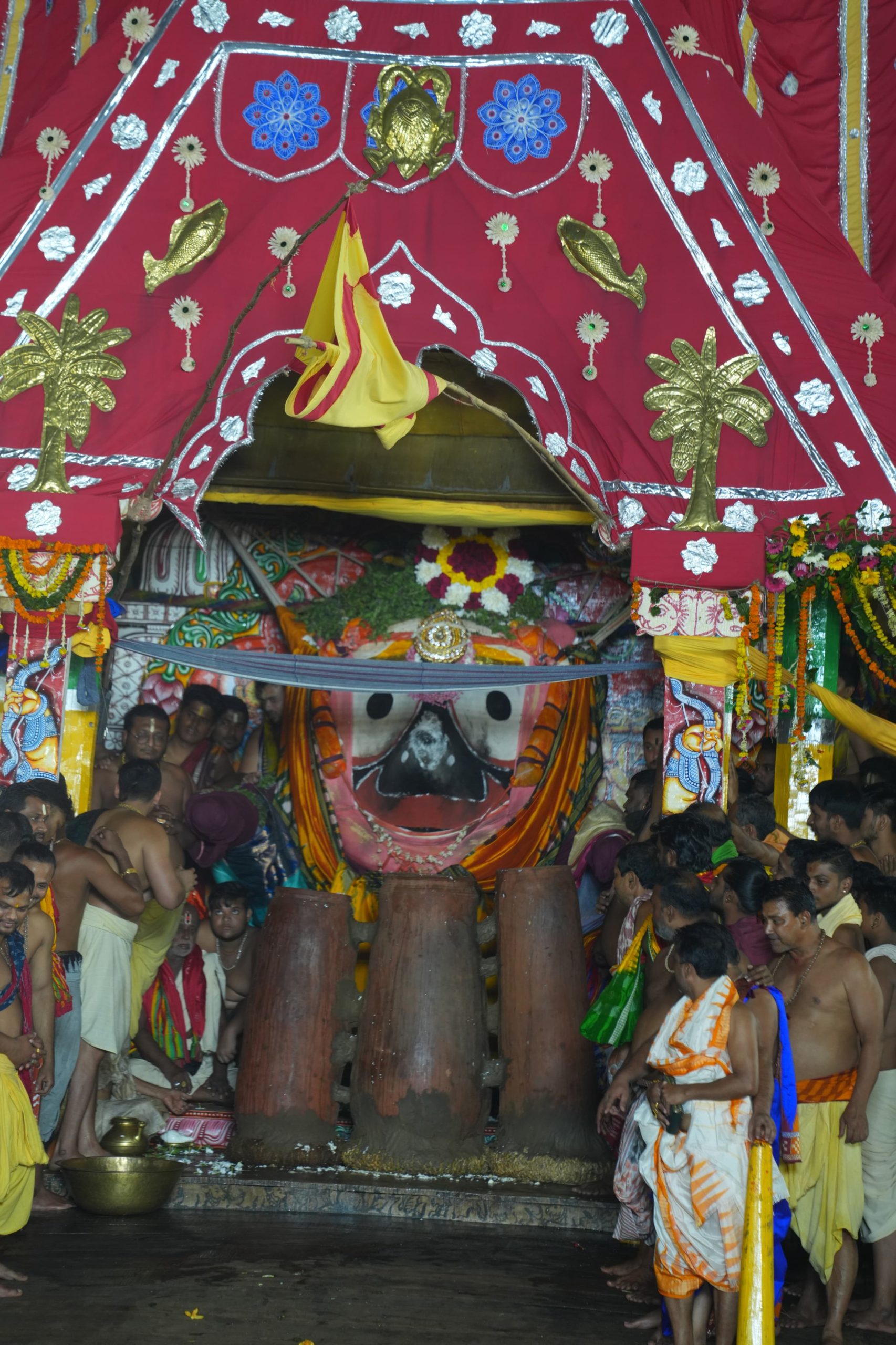Puri: Thousands of devotees today witnessed the sacred ‘Adhara Pana Niti’ in Puri, a revered ritual performed on the chariots of Lord Jagannath, Devi Subhadra, and Lord Balabhadra.
This significant ceremony, held on the Dwadashi of the bright fortnight of Ashadha, just a day prior to the deities’ return to the Srimandir (Niladri Bije), captivated a sea of devotees eager for a glimpse of the Lords enjoying the special offering.
The ‘Adhara Pana’ translates to ‘lip drink,’ referring to the unique sweet concoction offered. Nine large, barrel-shaped earthen pitchers, each standing approximately one meter tall, were meticulously filled with this sacred beverage. The ‘Pana’ itself is a rich blend of milk, cream, cheese, sugar, ripe bananas, camphor, nutmeg, and black pepper, specially prepared for the divine offering.
These pitchers were carefully placed before each deity on their respective chariots, positioned so that the rim of the pot almost touched their lips. The ritual, however, is not for human consumption. Instead, it is a profound symbolic act, believed to be an offering to the invisible spirits, ghostly bodies, and divine guards (Parsva Devatas) who have accompanied the Lords throughout the Rath Jatra.

Following the offering by the servitors, the earthen pitchers were intentionally smashed on the floor of the chariots. This act signifies the liberation and refreshment of these unseen entities, ensuring the drink is solely for spiritual beings and not for human consumption, granting them salvation and quenching their thirst. The specialized pots for this ritual are crafted by local potters from Kumbharpada, a process that takes nearly a month to complete.
To ensure a hassle-free and secure experience for the multitude of devotees, the Puri Administration and State Police had implemented extensive administrative and security measures for the Adhara Pana Niti and the broader Rath Jatra festivities.
A massive security deployment was evident across the town, with thousands of police personnel, including forces from BSF, CRPF, and Rapid Action Force (RAF), strategically positioned. Senior IPS officers were on the ground, meticulously coordinating all security operations.
Advanced surveillance systems were a key component of the security apparatus, with around 275 AI-enabled CCTV cameras monitoring crowd movements, traffic flow, and potential threats in real-time. These cameras were strategically installed along the festival route, from Uttara Chhak to Puri town and extending towards Konark. An Integrated Command and Control Room in Puri provided continuous monitoring capabilities.
Specialized units further augmented the security framework, with NSG snipers deployed on rooftops and anti-drone systems in place for aerial surveillance. Bomb disposal squads, canine units, and anti-sabotage teams were also part of the comprehensive security plan.

Crowd and traffic management were meticulously planned, with the town divided into designated zones for effective control. Strict traffic advisories were issued, complemented by designated parking areas and shuttle services to manage vehicle flow and alleviate congestion around the temple precincts. Road dividers and delineators were utilized to streamline devotee movement.
Given Puri’s coastal location, Odisha’s Marine Police, Coast Guard, and Indian Navy personnel were deployed to ensure robust security along the seafront. Emergency preparedness was also a priority, with National Disaster Response Force (NDRF) teams stationed in Puri, trained to handle various emergencies, including medical incidents and structure collapses. Mock drills were conducted in coordination with the district administration to ensure seamless response.
While the Shree Jagannath Temple Administration (SJTA) provided essential facilities for pilgrims during major festivals, including Bhakta Nivas (lodging houses) and public announcement systems to guide devotees.
Authorities emphasized a proactive approach to security, focusing on thorough planning, strict safety protocols, and continuous investment in infrastructure to manage large crowds effectively, aiming to enhance the overall experience for all pilgrims.


